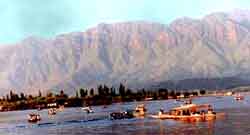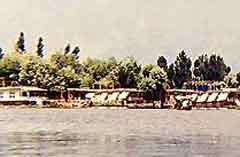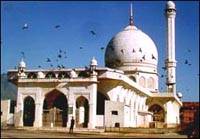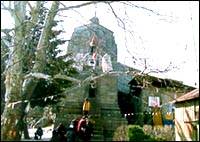| Destinations
|
|||||
Overview Hari Parbat, Srinagar's 'Takht-i- Sulaiman' hill forms the backdrop
to the city. The placid Jhelum flows through the heart of Srinagar
and the houseboat-filled Dal and Nagin Lakes dominate the scene.
From a tourist's point of view, a recommended initial exploration of
Srinagar begins on board a shikara that follows its course through
the heart of the city, past willow-shaded channels and canals, under
bridges. Deep green rice fields and bridges across rivers, splendid
Mughal gardens, water lilies and lotus. Lines of doongas are moored
along the banks, homes of the boat people. Women sit at the prows,
pounding grain or calling to each other. As a major artery, the
river is punctuated at regular intervals by landing stages leading
up to narrow labyrinth-like lanes which connect the streets beyond,
so that there is a constant flow of activity between water and land.
Homes, shops and schools, places of work and worship cluster around
the waterfront. Roof gardens and orchards tumble over the river
wall, and carved or latticed windows add a touch of timelessness.
Srinagar is the place for an aquatic sports enthusiast to try
kayaking, canoeing, water surfing and angling.
Landmarks |
More on Kashmir • Overview • History • People • Economy • Festivals • Wildlife • Adventure • Tourist Information • Climate Places to Visit: • Drass • Gulmarg • Jammu • Pahalgam • Sonamarg • Ladakh • More on Ladakh • Travelogues • Kashmir • Journey to Ladakh
Adventure |
||||
The fascination for houseboats led to the creation of a large number of luxurious floating hotels. Shikaras and houseboats vie for attention with their imaginative names. The increase in tourism has also had its downside. The Dal Lake shrunk to half its size, from 22 sq. km. to about 11 sq. km in 50 years, and is a reminder of the degradation in the Himalayan lake eco-system. Wular Lake Mughal Gardens Nagin Lake Manasbal Lake
Hari Parbat
Khir Bhawani (25 km) Awantipur(29 km) Achhabal (56 km) Accommodation There are also European style hotels, private guesthouses and tourist huts. The Boulevard is lined with hotels and restaurants to suit every budget. For information on tariffs, bookings and reservations you can get in touch with the Tourist Reception Centre at Srinagar. How to Get There Air : The nearest airport is about 25 km away in Badgam district. There are daily direct flights from Delhi. One can also fly in from Jammu. Rail : The nearest rail head is at Jammu, which is 300 kms away. Road Srinagar can be reached by road from Jammu. The hill resorts of Kud, Patnitop and Batote fall en route. The 2.5 km long Jawahar Tunnel allows road access to Srinagar even in the winter. This 293 km long journey passes through very picturesque landscape. Shopping Compiled by Puneet Sachdeva
|
|||||
Editor: Romola Butalia (c) India Travelogue. All rights reserved. |
|||||
 The lake
can be viewed in its full grandeur by walking or cycling down
Boulevard Road. It is divided in four parts by causeways known as
Gagribal, Lokut Dal, Bod Dal and Nagin.
The lake
can be viewed in its full grandeur by walking or cycling down
Boulevard Road. It is divided in four parts by causeways known as
Gagribal, Lokut Dal, Bod Dal and Nagin.
 of cascading streams and fountains, limpid pools and airy pavilions.
Laid out for the pleasure of the Mughal Emperors, they are ablaze
with multi hued flowers and they astound the senses with their
scents. Nishat borders the Dal Lake and was laid out by Asaf Khan,
Empress Nur Jahan's brother. Chasma Shahi, the Royal Spring, with an
illuminated garden, is the smallest. The spring from which it
derives its name is credited with medicinal properties. Shalimar,
the Abode of Love, was laid by Emperor Jahangir for his beloved
Queen Nur Jahan and is the most famous of the three.
of cascading streams and fountains, limpid pools and airy pavilions.
Laid out for the pleasure of the Mughal Emperors, they are ablaze
with multi hued flowers and they astound the senses with their
scents. Nishat borders the Dal Lake and was laid out by Asaf Khan,
Empress Nur Jahan's brother. Chasma Shahi, the Royal Spring, with an
illuminated garden, is the smallest. The spring from which it
derives its name is credited with medicinal properties. Shalimar,
the Abode of Love, was laid by Emperor Jahangir for his beloved
Queen Nur Jahan and is the most famous of the three.
 Hazratbal
Hazratbal Shankaracharya Hill
Shankaracharya Hill